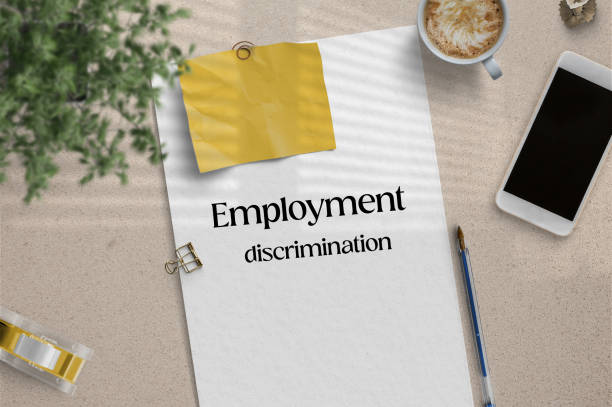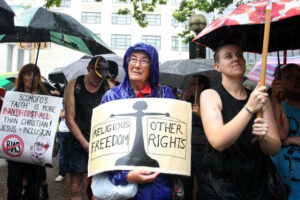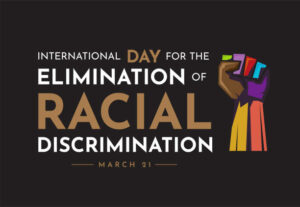
State by state analysis
New South Wales (NSW) – Anti-Discrimination Act 1977
Emerging in the late 1970s, the Act was among Australia’s first to grapple / deal with the various discrimination grounds. It materialized during a turbulent period, with the global civil rights movements gathering pace in Australia. People were looking for laws with equality and justice One of the Act’s standout features is its focus on racial discrimination. Recognizing NSW’s cultural diversity, considerable indigenous population, provisions addressing racial vilification became pivotal, fostering an inclusive atmosphere were introduced.
The Act considers numerous workplace scenarios. Discrimination during recruitment processes. Harassment or discrimination during employment. Discrimination in determining who should be offered employment. Discrimination in the terms or conditions of employment. Also discrimination in the provision of goods and services.
Over the years, the Act underwent several amendments. In the 1990s, the inclusion of provisions around disability discrimination showcased the Act’s evolving nature. However, critics argue the need for further updates, especially around digital discrimination in today’s age of social media. Employees became more vocal. Starting with internal grievance procedures within companies, matters can escalate to external bodies. Legal representation is permitted, and while it’s not mandatory, it can prove beneficial.
For New South Wales, the place to lodge claims is the Anti Discrimination Board.If the matter does not resolved it can be referred to the New South Wales Adminstrative Tribunal (NCAT). It has been pivotal in handling discrimination cases, guiding the aggrieved through the procedural intricacies. As one of the major business hubs, NSW has seen a range of compensations, with many reaching significant figures, especially in corporate sectors. While a specific figure-by-figure breakdown would require more granular data, it’s evident that states prioritize restitution for the aggrieved. However, variations exist due to factors like economic landscapes, demographic diversities, and the nature of reported cases.
Victoria – Equal Opportunity Act 2010
Victoria has always been at the forefront of progressive legislation. The 2010 iteration of the Act was a culmination of years of reflection and acknowledgment of the changing societal dynamics. Its provisions around age discrimination are particularly noteworthy. With an aging population, protecting senior employees from biases became essential. Sexual harassment, an alarming concern in many workplaces, receives thorough attention in the Act. It recognizes both overt and subtle forms of harassment, ensuring employees have a safe working environment. The Victorian Equal Opportunity and Human Rights Commission is a very proactive body.
The Act’s dynamic nature is evident in its periodic reviews. Feedback mechanisms are often integrated, sourcing opinions from the public, ensuring it remains representative and relevant. For employees, an array of resources is available, from informative pamphlets to seminars. These tools ensure they are well-equipped to recognize and report any infringements on their rights.
If complaints are not resolved they can proceed to the Victorian Civil and Administrative Tribunal (VCAT). VCAT offers a platform for people who believe they’ve faced discrimination. It is renowned for its accessibility and relative speed in handling disputes. Historically, figures have showcased substantial compensation, especially in cases involving institutional discrimination. (universities, hospitals, schools)

Queensland – Anti-Discrimination Act 1991
The Queensland Anti-Discrimination Act, enacted in the early 90s, aimed to harmonize state-level legislation with federal discrimination laws. A time of significant socio-political transformation, Queensland sought to recognize the evolving nature of discrimination and to offer redress. The Act prominently addresses issues related to pregnancy and breastfeeding, a nod to its commitment to promoting women’s rights and ensuring workplaces remain inclusive spaces for mothers.
Beyond typical discriminatory grounds, the Act ensures employees are protected from biases originating from family responsibilities, ensuring a balanced work-life atmosphere. Regularly amended to incorporate feedback and adapt to societal shifts, the Act now considers genetic information as a discriminatory ground, reflecting advancements in medical science and associated prejudices. In Queensland, the initial point of contact for aggrieved employees is the Queensland Human Rights Commission. They provide thorough guidance on navigating complaints, ensuring employees feel supported.
If complaints are not resolved then they are referred to the Queensland Civil and Administrative Tribunal (QCAT) Serving Queensland, QCAT’s inclusivity extends to a broad range of issues, from racial to gender-based discrimination. While there’s an emphasis on mediations and resolutions, compensation figures have been consistently substantial, particularly in workplace discrimination cases.
Western Australia – Equal Opportunity Act 1984
Western Australia, with its unique demographic and cultural milieu, needed a comprehensive piece of legislation by the mid-80s to reflect its commitment to equality, leading to this Act. Its approach to racial harassment stands out, offering a more detailed examination than some other states and recognizing the subtle nuances of racially-motivated maltreatment. Particularly noteworthy is the Act’s recognition of discrimination during apprenticeship or training programs, ensuring early career individuals aren’t marginalized.
There have been growing calls to re-evaluate the Act’s applicability to the digital age, given its age and the rapidly changing nature of online discrimination. The Equal Opportunity Commission WA offers an array of services to guide employees. From initial complaint registration to facilitated mediations, they aim for a holistic resolution process. If a complaint is not resolved it can be decided on in the State Adminstrative Tribunal (WA) referred to as (SAT).
Wardley v Western Australia (1992) This case revolved around the dismissal of a female employee who became pregnant. She claimed her dismissal was an act of discrimination. This case underscored the importance of understanding indirect discrimination. The court recognized that certain requirements, while appearing neutral, might adversely affect a particular group. With changing workplace dynamics and the push for equal parental rights, cases like Wardley resonate even today. It accentuates the necessity for laws to be malleable enough to understand and address subtler forms of discrimination.
South Australia – Equal Opportunity Act 1984
In the same year as Western Australia, South Australia ratified its Equal Opportunity Act, recognizing the state’s changing demographics and the need for a robust legal framework. Its emphasis on equal opportunity programs, especially in employment sectors, is pivotal, ensuring proactive measures against discrimination. The Act has a structured approach to address sexual harassment, recognizing both physical and verbal forms, safeguarding employees’ dignity.
The Act underwent several updates, with the inclusion of gender identity being a significant step, echoing global shifts in recognizing transgender rights. The Equal Opportunity SA aside from addressing grievances, offers training sessions for organizations, ensuring proactive steps towards discrimination-free workplaces. Complaints that are not resolved get decided in the South Australian Civil and Adminstrative Tribunal (SACAT)

Tasmania – Anti-Discrimination Act 1998
A relatively newer piece of legislation, Tasmania’s Act emerged in response to evolving understandings of discrimination, both locally and internationally. Its robust stance on “incite hatred” provisions makes it a gold standard, reflecting modern societal challenges, especially in a globally connected world.
Acknowledging relationship status, the Act ensures that employees aren’t discriminated against based on their personal life choices, be it marital status or partnerships. Given its relatively recent origin, the Act is fairly aligned with current dynamics. However, there are continuous evaluations to ensure it remains relevant. The Office of the Equal Opportunity Commissioner offers both mediation and public education services, ensuring employees have redressal options and are well-informed. Complaints that need to be decided are before the Tasmanian Civil and Adminstrative Tribunal (TASCAT).
Australian Capital Territory (ACT) – Discrimination Act 1991
The late 20th century witnessed a societal awakening across many parts of the world, including Australia. The ACT, in alignment with these values, introduced its Discrimination Act to provide its citizens a local framework, ensuring their rights weren’t infringed upon based on biased grounds. Unique to the ACT is its specific inclusion of areas such as profession, trade, calling, or vocation as potential grounds for discrimination, reflecting the region’s diverse employment landscape.
The Act is exhaustive when it comes to employment-related discriminations. Whether it’s about promotions, training, or workplace benefits, the legislation ensures that no employee is sidelined based on any discriminatory grounds. With the advent of digital spaces and the shifting dynamics of modern workplaces, there have been voices advocating for the Act to incorporate newer forms of discriminations and harassments, particularly those originating online.
The ACT Human Rights Commission plays a pivotal role in ensuring that aggrieved employees have a clear and structured path. From the initial stages of lodging a complaint to facilitating mediations, they ensure that the process remains transparent and supportive. Matters that require a ruling go before ACT Civil and Adminstrative Tribunal (ACAT)
Northern Territory – Anti-Discrimination Act 1992
Given the Territory’s rich cultural and indigenous history, it was imperative for the Northern Territory to have a robust anti-discrimination framework. The 1992 Act is a testament to this commitment. The Act takes into account the Territory’s unique blend of urban and indigenous populations. Its provisions around association with a child and breastfeeding are particularly noteworthy, reflecting the region’s familial and community-centric values.
For employees, the Act provides a solid backing, ensuring that every phase of their employment journey, from recruitment to potential redundancies, remains free from biases and prejudices. While the Act remains a strong piece of legislation, there have been discussions around its potential overlap with federal laws and the need to harmonize certain provisions. The Northern Territory Anti-Discrimination Commission ensures employees aren’t left to fend for themselves. With a comprehensive complaint registration system and a methodical approach to address grievances, they remain a cornerstone in the Territory’s fight against discrimination.If matters need to go further and be ruled on they go to the Northern Territory Civil and adminstative Tribunal (NTCAT).

Australian Human Rights Commission (AHRC)
The overarching nature of federal legislation provides a uniform framework for all Australian states and territories. The Racial Discrimination Act 1975, Sex Discrimination Act 1984, Disability Discrimination Act 1992, and the Age Discrimination Act 2004 play crucial roles in setting the tone for state-specific laws. Emerging from international obligations and treaties, these federal laws symbolize Australia’s commitment on the world stage to battle discrimination in all its forms. Federal legislation often serves as a benchmark for states and territories, with their comprehensive approach, reflecting the nation’s collective consciousness.
They ensure that irrespective of which part of Australia an employee is, certain fundamental rights remain non-negotiable, setting a national standard. Regularly updated, these Acts cater to Australia’s changing socio-economic fabric. As societal perceptions evolve, so do these federal laws, ensuring their continued relevance. At the federal level, the Australian Human Rights Commission (AHRC) stands as a sentinel, ensuring that discriminatory practices are swiftly addressed. Offering a wide range of resources, they ensure employees across Australia have a consistent standard of redressal.
Though not an NGO in the traditional sense, the AHRC functions with an independence akin to one. It’s instrumental in addressing human rights violations, which includes discrimination. They frequently release reports that shape national dialogue and influence policy amendments. Their contributions range from advocacy to research and on-ground support for victims. Matters unresolved may elect to proceed to the Federal Court.
Landmark Cases
A comprehensive understanding of anti-discrimination laws is incomplete without examining landmark cases. These cases not only shape the interpretation of the legislation but also inform potential future amendments.
Bropho v Human Rights & Equal Opportunity Commission (1990). This case from Western Australia revolved around the controversial Fremantle logo issue, which was considered derogatory towards Aboriginals. This was one of the pioneering racial discrimination cases in Australia. It highlighted the cultural sensitivities and led to a renewed consciousness about indigenous rights.
Purvis v New South Wales (Department of Education and Training) (2003). This case focused on a student with a disability being expelled from school due to his aggressive behaviour, a consequence of his disability. The case clarified the term “disability” in the Disability Discrimination Act 1992. It showcased the necessity of institutions adapting and accommodating individuals with unique needs.
Richardson v Oracle Corporation Australia Pty Limited (2014). This case involved a female employee who faced sexual harassment from a male colleague. Besides leading to a significant compensation, this case set a precedent for future damages for pain and suffering in sexual harassment claims, urging companies to strengthen their internal policies.

Challenges & Future Outlook for Anti-discrimination Laws
Digital Era Discrimination
With cyberbullying, online harassment, and digital forms of racial and sexual discrimination on the rise, there’s a pressing need for laws to evolve rapidly. As workplaces become more virtual, there’s an urgency to tackle digital workplace harassment head-on.
Intersectional Discrimination
It’s increasingly being recognized that individuals can face discrimination on multiple fronts simultaneously. For instance, an individual could face prejudice due to race, gender, and age concurrently. Laws need to account for this multi-faceted discrimination.
Broadening Gender Definitions
As societal understanding of gender becomes more nuanced, anti-discrimination laws need to reflect this. Recognition of non-binary, transgender, and other gender identities is essential.
What about Employee Empowerment
Awareness Campaigns
While laws exist, it’s crucial for employees to be aware of their rights. State-sponsored campaigns, workshops, and training sessions can be monumental in this aspect. Often, individuals are unable to pursue their grievances due to financial constraints. An established system of legal aid for discrimination cases would ensure justice isn’t denied.
Anonymous Reporting Mechanisms
Fear of retaliation often dissuades employees from reporting discrimination. Anonymous systems can help assuage these concerns, ensuring wrongdoings are highlighted without repercussions. Emotional and psychological support post any discrimination incident is vital. Instituting mandatory counselling for affected employees can facilitate better healing.
The Tribunal systems and their benefits
Typically faster than court systems, they offer rapid redressal. Generally, tribunal proceedings are less expensive than traditional court cases. Tribunals are better equipped to handle specific nuances related to discrimination cases. With a less rigid procedural structure, they can adapt to individual case needs.
Their capacity to adjudicate is restricted to the ambit of specific laws. In certain instances, decisions made by tribunals might be challenging to appeal. Given the high volume of cases, they may face operational and resource-based challenges.

Ensuring Employee Rights in Changing Workplace Dynamics
The very definition of a workplace has seen a shift in recent years. Remote working, freelancing, and the gig economy demand a re-evaluation of existing laws. With the surge of work-from-home setups, ensuring a discrimination-free environment is challenging. Employers must ensure policies cover online interactions and virtual meetings.
The protection extended to traditional employees must be provided to freelancers. Their vulnerable position, coupled with contractual work, often exposes them to potential biases without the regular channels of redressal. The more diverse a workplace, the richer its potential. Mandatory training sessions on diversity and inclusion can ensure an organic shift towards a more inclusive workspace. While each state and territory in Australia maintains its framework, analyzing compensation figures provides a glimpse into how these laws play out practically.
International Comparisons: Australia in a Global Context
Assessing Australia’s anti-discrimination laws in relation to its global counterparts offers valuable insights, highlighting areas of strength and potential improvement.
Canada. The Canadian Human Rights Act and provincial human rights codes. Canada is particularly lauded for its broad protection against discrimination, including that based on genetic characteristics. Unlike Australia’s state-based approach, Canada’s division is more provincial. However, like Australia, Canada also has a federal law that provides a baseline.
United Kingdom. The Equality Act 2010. The Act consolidates numerous preceding acts and regulations into one comprehensive piece of legislation, ensuring clarity. While Australia’s laws have evolved and expanded over several decades, the UK’s approach to consolidate them provides a streamlined understanding. Australia might benefit from a similar consolidation for more straightforward national guidance.
United States. Landmark Civil Rights Act of 1964, Americans with Disabilities Act, and several state-specific laws. Robust legislation with substantial punitive measures. Specific acts, like the ADA, focus on particular aspects of discrimination, offering a laser-focused approach. Unlike Australia’s more inclusive and general anti-discrimination laws, the US tends to have more targeted legislation, addressing specific issues individually.
Potential Reforms & Future Challenges
While Australia’s anti-discrimination laws are extensive, there’s always room for inclusion. Factors like socio-economic status, political beliefs, or even refugee/migrant status could be grounds for future inclusion. As previously mentioned, the digital era brings new challenges. Discrimination in virtual spaces can be even more insidious, given its anonymity. Crafting laws that address cyber-discrimination without infringing on digital rights will be a fine balancing act.
Given the varying laws across states, there might be a call for more harmonized regulations. While individual state nuances are crucial, a more streamlined national understanding could aid in more consistent interpretation and application. As society becomes more aware, there’s likely to be an increase in reported cases. Ensuring the tribunals and commissions are equipped to handle this surge, both in terms of resources and expertise, will be vital.

Other unmeasured benefits
Companies with more inclusive environments often report higher productivity. When employees feel valued and free from prejudice, their job satisfaction and, consequently, their output often increases. A country known for its stringent anti-discrimination laws naturally becomes more appealing to global talent. Professionals from diverse backgrounds feel more inclined to work in environments where their rights are protected.
A robust understanding and implementation of anti-discrimination laws can save companies millions in potential lawsuits. An upfront investment in training and awareness can prevent substantial downstream costs. In an age where corporate social responsibility is paramount, businesses that actively promote inclusivity and take a stand against discrimination are often viewed more favourably by consumers. This can have direct positive implications for a company’s bottom line.
As Australia’s population ages, age discrimination, especially in the workplace, is coming to the forefront. Ensuring older Australians remain active, valued members of the workforce will be a challenge that necessitates nuanced legal approaches. LGBTQ+ Rights. Though Australia has made significant strides, especially with the legalization of same-sex marriage, there’s always room for improvement in ensuring LGBTQ+ rights. As societal understanding of gender and sexuality evolves, so must the legislation.
Other unmeasured concerns
Given its public-facing nature, the service industry often grapples with issues related to discrimination, both from patrons and within the staff hierarchy. Discrimination based on appearance or ethnicity can be a significant concern. Furthermore, the service industry, especially sectors like hospitality, can sometimes harbour gender biases.
The tech sector, globally and in Australia, has been critiqued for a lack of diversity. The rapid growth of startups often means that proper diversity protocols may not always be implemented from the outset. Underrepresentation of women and minorities, particularly in leadership roles, and a bro-culture can sometimes perpetuate biases.
Construction & Manual Labor. These sectors have historically been male-dominated and might present challenges for individuals outside of this demographic.
Current Initiatives & Case Studies
Telstra. One of Australia’s leading telecommunications and technology companies, Telstra has initiated various programs to boost diversity and inclusion. From enhancing gender representation to supporting Indigenous employees, their multi-faceted approach serves as a benchmark for corporate Australia.
ANZ Bank. Financial institutions play a critical role in shaping corporate cultures. ANZ, with its numerous initiatives focusing on gender representation, LGBTQ+ inclusion, and support for individuals with disabilities, showcases how large entities can drive change.
Atlassian. A global name in the technology sector, Atlassian’s Australian roots make its commitment to diversity all the more noteworthy. Their regular diversity reports, coupled with actionable insights, underscore the importance of transparency and accountability.

Profound Implications of discrimination
Discrimination, whether overt or covert, has profound implications not just for individuals but also for the broader fabric of society. For Australia, a nation built on diversity, the stakes are even higher. While the legal framework offers a solid foundation, the real change is driven by everyday actions, corporate responsibilities, and societal introspection. The collective endeavor is and should always be, an Australia where equality isn’t just a term but an everyday reality.
While the legal and economic aspects of discrimination are often discussed, the psychological ramifications, which are deeply profound and lasting, can sometimes be overlooked. Discrimination, in any form, can have severe mental health consequences for the affected individuals. Experiencing discrimination can lead to conditions such as depression, anxiety, and post-traumatic stress disorder. Constant exposure to prejudicial treatment can erode an individual’s self-worth and confidence.
Those who face regular discrimination might choose to isolate themselves from situations where they feel vulnerable, furthering feelings of loneliness and exacerbating mental health conditions. The stress stemming from facing discrimination doesn’t just affect mental health but can manifest in physical symptoms, including headaches, high blood pressure, and other stress-related conditions.
Older Australians
For those facing discrimination in academic or professional settings, the psychological strain can adversely affect their performance, creating a vicious cycle where the individual’s fears about underperforming due to discrimination become a self-fulfilling prophecy.
Given the inherent transient nature of their work, migrant workers often find themselves in precarious situations, susceptible to exploitation and discrimination. This vulnerability stems from unfamiliarity with Australian laws, fear of reporting due to potential repercussions, and sometimes language barriers.Age discrimination, especially in the workforce, is a pressing issue. Older Australians often find it challenging to secure jobs, facing biases that question their adaptability and relevance in fast-evolving industries.While legal frameworks protect the rights of individuals with disabilities, real-world scenarios often see them facing discrimination in various facets of life, from employment opportunities to social inclusion.

Movements Driving Awareness
Over the years, various movements and initiatives have worked tirelessly to raise awareness about discrimination and advocate for equal rights in Australia. The Indigenous Rights Movement Spearheaded by organizations like the National Aboriginal and Torres Strait Islander Legal Services, there has been a significant push for the rights of Indigenous Australians, drawing attention to the systemic discrimination they face.
LGBTQ+ Pride: Mardi Gras, one of the most prominent LGBTQ+ celebrations globally, goes beyond festivities. It’s a powerful statement against discrimination based on sexual orientation and gender identity, advocating for equality and acceptance. Gender Equality Movements: Organizations like the Australian Women’s Health Network work to highlight and rectify gender disparities and discrimination in various sectors.
Anti-Racism Initiatives: Movements like “Racism. It Stops With Me” have been pivotal in creating a societal dialogue around racial discrimination and the steps individuals can take to combat it.
Conclusion
Firstly, thank you for reading this article, it is a bit long, but I’m sying to be informative as I can .Australia’s commitment to combatting discrimination, while commendable, remains a work in progress. It’s a multi-faceted issue that demands constant vigilance, adaptability, and most importantly, a society-wide commitment. It’s no different to climate change. It can be controversal and forvever changing. It’s imperative to remember that every act against discrimination, no matter how small, contributes to the larger goal – an inclusive, just, and equitable Australia.
Call 1800 333 666 for advice. Its prompt, free and confidential.






